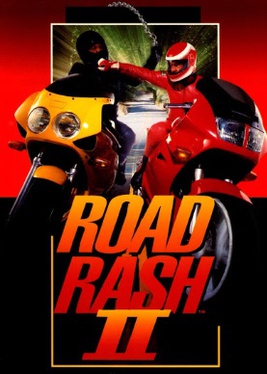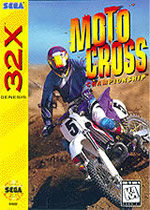
Road Rash is a motorcycle racing video game series by Electronic Arts in which the player participates in violent, illegal street races. The series started on the Sega Genesis/Mega Drive and was released on various other systems over the years. The game's title is based on the slang term for the severe friction burns that can occur in a motorcycle fall where skin comes into contact with the ground at high speed.

Primal Rage is a fighting game developed and released by Atari Games to arcades in 1994. The game takes place on a post-apocalyptic version of Earth called "Urth". Players control one of seven large beasts that battle each other to determine the planet's fate. Matches feature many of the conventions of fighting games from the era, including special moves and gory finishing maneuvers. Ports were released for home consoles and personal computers. Efforts to perfectly emulate the arcade original have been unsuccessful due to the use of an unusual copy protection method. Toys, comics, a novel and other merchandise tie-ins were produced. More than 1.5 million copies of the game were sold.

FIFA International Soccer is a 1993 association football video game developed by EA Canada's Extended Play Productions team and published by Electronic Arts. The game was released for the Sega Mega Drive/Genesis console in December 1993 and ported to numerous other systems in 1994. It is the first game in the FIFA series.
XBAND was one of the first competitive online console gaming networks and was available for the Genesis and Super NES. It was produced by Catapult Entertainment in Cupertino, California. It is the only modem released in America to have been officially licensed by Nintendo. It debuted in various areas of the United States between November 1994 and June 1995 and was later released nationwide between October 2 and 8, 1995.

Rad Mobile is a racing arcade game developed by Sega AM3 and published by Sega. It was first published in Japan in October 1990, followed by an international release for arcades in February 1991. Rad Mobile was Sega's first 32-bit game, using Sega's System 32 arcade system board. It was also the first appearance of Sonic the Hedgehog, who appears as an ornament hanging from the driver's rearview mirror.

The Lion King is a platform game based on Disney's 1994 animated film The Lion King. The game was developed by Westwood Studios and published by Virgin Interactive Entertainment for the Super NES and Genesis in 1994, and was ported to MS-DOS, Amiga, Game Gear, Master System, and Nintendo Entertainment System. The Amiga, Master System, and NES versions were only released in the PAL region. It is the final licensed NES game worldwide. The game follows Simba's journey from a young cub to the battle with his uncle Scar as an adult.

Kawasaki Superbike Challenge is a multiplatform racing video game where the player takes the role of a Kawasaki factory rider in an unnamed fictional racing series.

Road Rash II is a 1992 racing and vehicular combat game developed and published by Electronic Arts (EA) for the Sega Genesis. The game is centered around a series of motorcycle races throughout the United States that the player must win to advance to higher-difficulty races, while engaging in unarmed and armed combat to hinder the other racers. It is the second installment in the Road Rash series and introduces a split-screen two-player mode for competing human players, nitrous oxide charges on certain bikes, and chains as offensive weapons.

Skitchin' is a 1994 racing video game developed and published by Electronic Arts (EA) for the Sega Genesis. The game puts the player in control of an inline skater who must win races in a tournament while engaging in unarmed and armed combat with other skaters and partaking in skitching, the act of clutching onto a moving vehicle's bumper to gain momentum.

Desert Demolition Starring Road Runner and Wile E. Coyote is a platform video game developed by BlueSky Software and published by Sega for the Sega Genesis. The game was released in North America in February 1995 and in Europe the following month. The game is based around Wile E. Coyote and the Road Runner, who are the game's player characters and are tasked with playing through a series of levels as they respectively pursue and evade the other. The game was re-released as part of the Sega Mega Hits range in September 1997.

ESPN Extreme Games is a game released for the PlayStation in 1995. A version was released for MS-DOS a short time later. The game featured all the sports included in the Summer X-Games of 1995, but it did not feature events such as the half pipe in skateboarding. It was similar to Road Rash, which was a game published by Electronic Arts. The game was followed by two sequels, 2Xtreme and 3Xtreme.

Motocross Championship is a racing video game developed by Artech Studios for the 32X. It was released in 1995. The premise of the game is based on motocross racing across twelve different tracks, while being able to attack opponents during the race. Motocross Championship received mixed reviews, with criticism on multiple aspects of the game. Some reviewers have suggested the game's quality impacts the 32X negatively.

Mortal Kombat is a 1992 fighting game developed and published by Midway. It is the first entry in the Mortal Kombat series and was subsequently released by Acclaim Entertainment for nearly every home platform at that time. The game focuses on several characters of various intentions who enter a martial arts tournament with worldly consequences. It introduced many key aspects of the Mortal Kombat series, including the unique five-button control scheme and gory finishing moves called Fatalities.

Road Rash 64 is a racing video game developed by Pacific Coast Power and Light and published by THQ for the Nintendo 64. The game is the fifth of six entries in the Road Rash series of video games, the only entry to be published by THQ and the only to be released for the Nintendo 64 platform.

Disney's Aladdin is a 1994 video game developed by SIMS Co., Ltd. for the Game Gear and Master System. Based on the film of the same name, Disney's Aladdin is a side-scrolling platform game in which the player character is Aladdin.

Road Rash is a 1991 racing and vehicular combat video game originally developed and published by Electronic Arts (EA) for the Sega Genesis. It was subsequently ported to a variety of contemporary systems by differing companies. The game is centered around a series of motorcycle races throughout California that the player must win to advance to higher-difficulty races, while engaging in unarmed and armed combat to hinder the other racers.

Road Rash is a 1994 racing and vehicular combat video game originally published by Electronic Arts (EA) for the 3DO Interactive Multiplayer. A version for the Sega CD was developed simultaneously and released in 1995 to act as a "bridge" between the 3DO version and the Sega Genesis title Road Rash 3, and the game was subsequently ported to the PlayStation, Sega Saturn, and Microsoft Windows in 1996. The game is the third installment in the Road Rash series, and is centered around a series of motorcycle races throughout California that the player must win to advance to higher-difficulty races, while engaging in unarmed and armed combat to hinder the other racers.
















